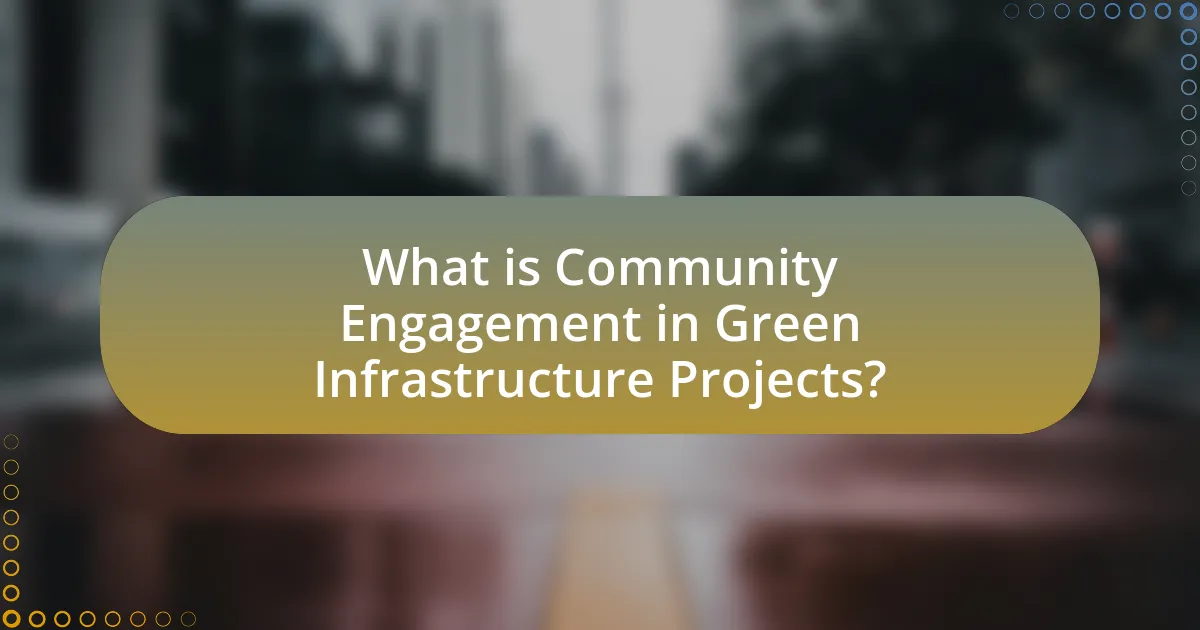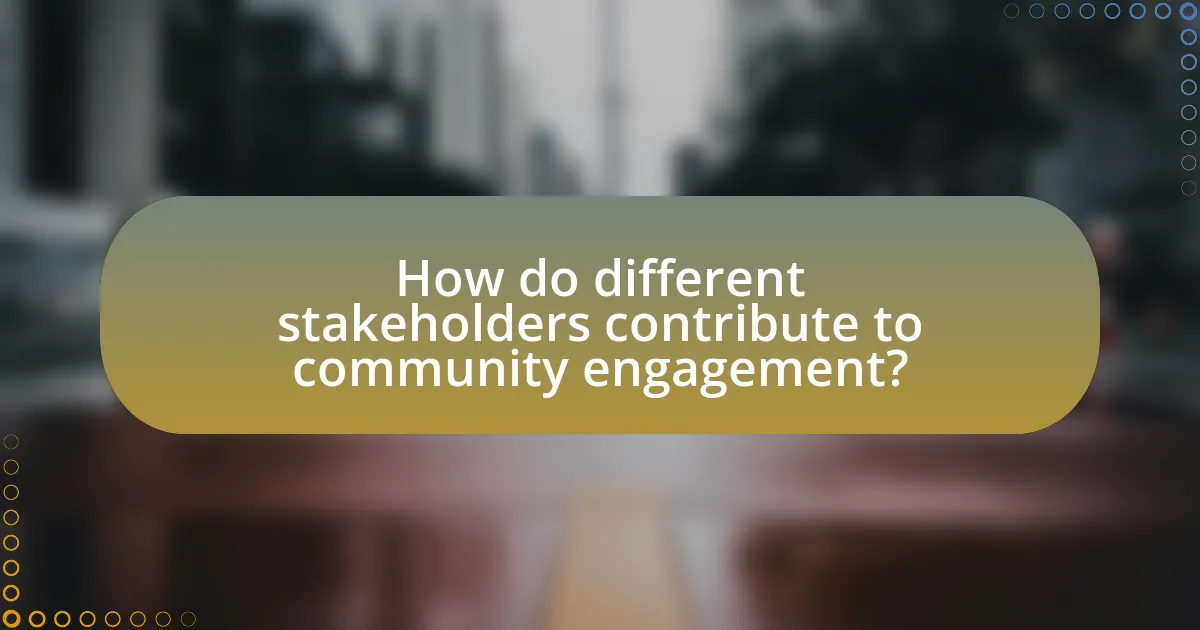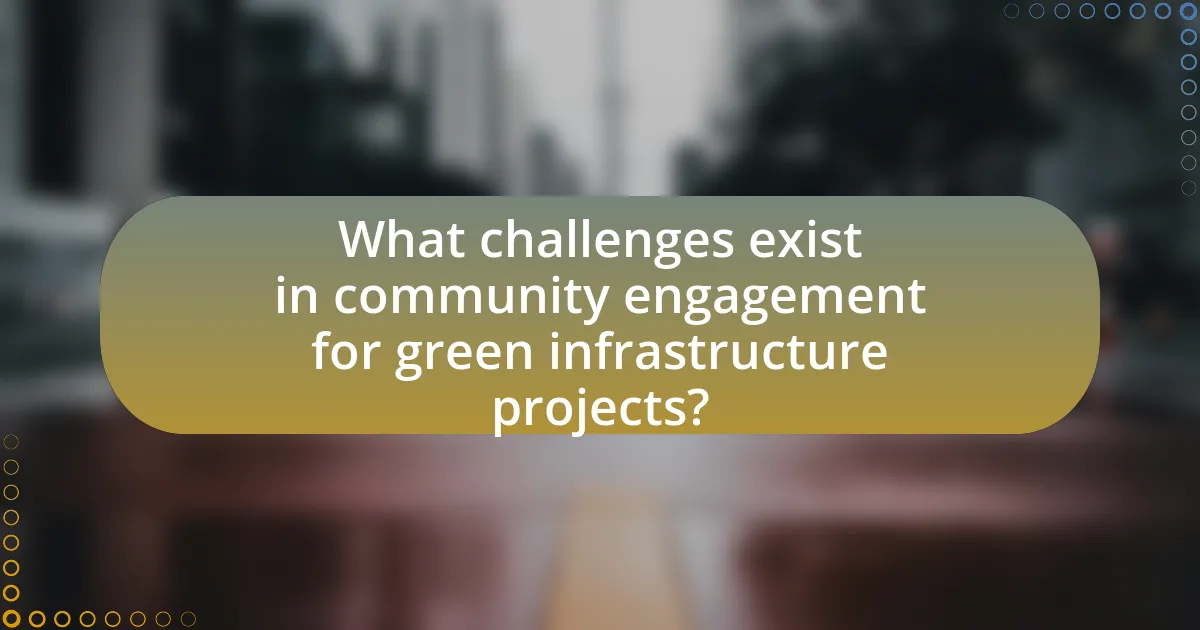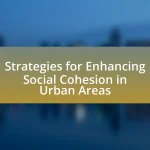Community engagement in green infrastructure projects involves the active participation of local communities in the planning, design, implementation, and maintenance of sustainable infrastructure. This article outlines the importance of community involvement, highlighting its role in enhancing project success, fostering collaboration, and ensuring that local needs are met. Key principles such as inclusivity, transparency, and sustainability are discussed, along with strategies for effective engagement, including the use of technology and participatory planning methods. Additionally, the article addresses challenges faced in community engagement, such as language barriers and misconceptions, while providing practical steps and best practices for successful collaboration among stakeholders.

What is Community Engagement in Green Infrastructure Projects?
Community engagement in green infrastructure projects refers to the active involvement of local communities in the planning, design, implementation, and maintenance of environmentally sustainable infrastructure. This engagement ensures that the needs, preferences, and insights of community members are integrated into project development, leading to more effective and accepted solutions. Studies have shown that projects with strong community involvement, such as the Green Streets Initiative in Portland, Oregon, result in higher satisfaction rates and better environmental outcomes, as they reflect the values and priorities of the residents.
Why is community engagement important in green infrastructure projects?
Community engagement is important in green infrastructure projects because it ensures that the needs and preferences of local residents are incorporated into the planning and implementation processes. Engaging the community fosters a sense of ownership and responsibility, which can lead to increased support for the project and its long-term sustainability. Studies have shown that projects with strong community involvement are more likely to succeed; for instance, a report by the American Planning Association found that community-driven initiatives often result in better environmental outcomes and enhanced social cohesion.
What role does community input play in project design?
Community input is essential in project design as it ensures that the needs and preferences of the local population are integrated into the planning process. Engaging the community allows project designers to gather valuable insights, which can lead to more effective and sustainable outcomes. Research indicates that projects incorporating community feedback are more likely to achieve higher satisfaction rates and better long-term success, as evidenced by a study published in the Journal of Environmental Management, which found that community involvement in green infrastructure projects significantly improved project acceptance and usability.
How does community engagement influence project success?
Community engagement significantly enhances project success by fostering collaboration, increasing stakeholder buy-in, and ensuring that the project meets the actual needs of the community. Engaged communities are more likely to support initiatives, leading to higher participation rates and resource mobilization. For instance, a study by the American Planning Association found that projects with strong community involvement are 50% more likely to be completed on time and within budget. This correlation underscores the importance of integrating community feedback and participation in the planning and execution phases, ultimately resulting in more sustainable and accepted outcomes.
What are the key principles of community engagement in these projects?
The key principles of community engagement in green infrastructure projects include inclusivity, transparency, collaboration, and sustainability. Inclusivity ensures that diverse community voices are heard and represented, fostering a sense of ownership among stakeholders. Transparency involves open communication about project goals, processes, and outcomes, which builds trust within the community. Collaboration emphasizes partnerships between community members, local organizations, and government entities, enhancing resource sharing and collective problem-solving. Sustainability focuses on creating long-term benefits for the community, ensuring that projects meet current needs without compromising future generations. These principles are supported by case studies demonstrating successful community-driven initiatives that have led to improved environmental and social outcomes.
How can transparency be maintained throughout the engagement process?
Transparency can be maintained throughout the engagement process by ensuring open communication, regular updates, and accessible information sharing. Open communication involves actively soliciting feedback from community members and addressing their concerns promptly, which fosters trust. Regular updates on project progress and changes keep stakeholders informed and engaged, reducing misinformation. Accessible information sharing, such as providing materials in multiple formats and languages, ensures that all community members can participate meaningfully. Research indicates that projects with high transparency levels lead to increased community support and better project outcomes, as evidenced by the findings in the “Community Engagement in Green Infrastructure Projects” report by the Environmental Protection Agency, which highlights the importance of transparency in fostering community trust and collaboration.
What methods can be used to foster inclusive participation?
To foster inclusive participation in community engagement for green infrastructure projects, methods such as stakeholder mapping, participatory planning, and the use of technology can be employed. Stakeholder mapping identifies all relevant community members, ensuring diverse voices are represented. Participatory planning involves community workshops and forums that encourage input from various demographics, enhancing the decision-making process. Additionally, technology, such as online surveys and social media platforms, can facilitate broader outreach and engagement, allowing for real-time feedback and interaction. These methods have been shown to improve community buy-in and project success, as evidenced by case studies in urban planning where inclusive practices led to higher satisfaction rates among residents.

How do different stakeholders contribute to community engagement?
Different stakeholders contribute to community engagement by leveraging their unique resources, expertise, and perspectives to foster collaboration and participation. Local governments facilitate engagement through policy frameworks and funding, while non-profit organizations mobilize community members and provide educational resources. Businesses can contribute by offering financial support and promoting sustainable practices, while residents play a crucial role by voicing their needs and participating in decision-making processes. Research indicates that effective community engagement in green infrastructure projects leads to increased public support and better project outcomes, as seen in case studies where diverse stakeholder involvement resulted in enhanced environmental benefits and community satisfaction.
Who are the primary stakeholders in green infrastructure projects?
The primary stakeholders in green infrastructure projects include local governments, community organizations, environmental groups, private developers, and residents. Local governments are responsible for planning and implementing these projects, while community organizations and environmental groups advocate for sustainable practices and community needs. Private developers often collaborate with public entities to integrate green infrastructure into their projects, and residents provide essential input and feedback, ensuring that the initiatives meet local needs and preferences. This multi-stakeholder approach enhances the effectiveness and acceptance of green infrastructure solutions.
What roles do local governments play in community engagement?
Local governments play a crucial role in community engagement by facilitating communication between residents and decision-makers. They organize public meetings, workshops, and forums to gather input on community needs and preferences, ensuring that citizens have a voice in local governance. For instance, local governments often utilize surveys and feedback mechanisms to assess community priorities, which helps shape policies and projects, including those related to green infrastructure. This engagement is vital for fostering trust and collaboration, as evidenced by studies showing that communities with active local government participation in planning processes report higher satisfaction with public services and initiatives.
How can non-profit organizations enhance community involvement?
Non-profit organizations can enhance community involvement by actively engaging local residents in decision-making processes and project implementation. By organizing workshops, focus groups, and community meetings, these organizations can gather input and foster a sense of ownership among community members. Research indicates that when communities are involved in the planning stages of green infrastructure projects, such as urban parks or community gardens, participation rates can increase by up to 50%, leading to more sustainable and accepted outcomes. Furthermore, partnerships with local schools and businesses can amplify outreach efforts, ensuring diverse community representation and support.
What strategies can stakeholders use to engage the community effectively?
Stakeholders can engage the community effectively by implementing inclusive communication strategies, fostering partnerships, and utilizing participatory planning methods. Inclusive communication ensures that diverse community voices are heard, which can be achieved through public forums, surveys, and social media outreach. Fostering partnerships with local organizations and community leaders enhances trust and collaboration, as evidenced by successful green infrastructure projects that have involved local stakeholders in decision-making processes. Participatory planning methods, such as workshops and design charrettes, allow community members to contribute ideas and feedback, leading to solutions that reflect their needs and preferences. Research shows that projects with high community involvement are more likely to succeed and be maintained over time, highlighting the importance of these strategies in community engagement.
How can social media be leveraged for community engagement?
Social media can be leveraged for community engagement by facilitating real-time communication and interaction among community members and stakeholders. Platforms like Facebook, Twitter, and Instagram allow organizations to share updates, gather feedback, and promote events related to green infrastructure projects. For instance, a study by the Pew Research Center found that 69% of adults in the U.S. use social media, making it an effective tool for reaching a broad audience. Additionally, social media enables the use of targeted campaigns to engage specific demographics, enhancing participation in community discussions and initiatives.
What are the benefits of hosting community workshops?
Hosting community workshops fosters collaboration and enhances community engagement in green infrastructure projects. These workshops provide a platform for residents to voice their concerns, share ideas, and contribute to decision-making processes, which can lead to more effective and sustainable outcomes. Research indicates that community involvement in planning processes increases project acceptance and success rates, as seen in the case of the Green Infrastructure Project in Philadelphia, where community feedback significantly shaped the design and implementation of green spaces. Additionally, workshops can educate participants about environmental issues, promoting awareness and encouraging stewardship of local resources.

What challenges exist in community engagement for green infrastructure projects?
Challenges in community engagement for green infrastructure projects include lack of awareness, diverse stakeholder interests, and limited resources. Many community members may not understand the benefits of green infrastructure, leading to apathy or resistance. Additionally, differing priorities among stakeholders, such as local government, residents, and environmental groups, can complicate consensus-building. Limited financial and human resources often hinder effective outreach and engagement efforts, making it difficult to involve all relevant parties. These factors collectively impede successful collaboration and implementation of green infrastructure initiatives.
What barriers do communities face in participating in these projects?
Communities face several barriers in participating in green infrastructure projects, including lack of funding, insufficient knowledge, and limited access to decision-making processes. Funding constraints often hinder community initiatives, as many projects require financial resources that are not readily available. Additionally, a lack of knowledge about green infrastructure benefits and implementation can prevent community members from engaging effectively. Limited access to decision-making processes further exacerbates these issues, as communities may feel excluded from discussions that directly impact their environment and well-being. These barriers collectively reduce community participation and the potential success of green infrastructure initiatives.
How can language and cultural differences impact engagement?
Language and cultural differences can significantly impact engagement by creating barriers to communication and understanding among community members. When individuals speak different languages or come from diverse cultural backgrounds, misinterpretations can occur, leading to reduced participation in discussions and decision-making processes. For instance, a study by the American Planning Association found that effective communication in community engagement efforts is crucial for fostering trust and collaboration, which are essential for successful green infrastructure projects. Additionally, cultural norms influence how individuals perceive environmental issues and their willingness to engage, as demonstrated by research from the Journal of Environmental Management, which highlights that culturally relevant messaging increases community involvement.
What are the common misconceptions about community engagement?
Common misconceptions about community engagement include the belief that it is solely about informing the community or that it only involves participation in decision-making processes. Many assume that community engagement is a one-time event rather than an ongoing relationship-building process. Additionally, some people think that engagement is only necessary for controversial projects, overlooking its importance in all types of initiatives. Research indicates that effective community engagement fosters trust and collaboration, which are essential for successful outcomes in projects, particularly in green infrastructure initiatives.
How can these challenges be overcome?
To overcome challenges in community engagement for green infrastructure projects, stakeholders must prioritize inclusive communication strategies. Engaging diverse community members through workshops, surveys, and public meetings ensures that all voices are heard and considered in the planning process. Research by the American Planning Association indicates that inclusive engagement leads to higher community satisfaction and project success rates, as it fosters trust and collaboration among residents and planners. Additionally, providing clear information about the benefits and impacts of green infrastructure can alleviate concerns and misconceptions, further enhancing community buy-in.
What best practices can be implemented to improve engagement?
To improve engagement in community involvement for green infrastructure projects, best practices include fostering open communication, involving stakeholders early, and providing educational resources. Open communication ensures that community members feel heard and valued, which can increase their willingness to participate. Involving stakeholders early in the planning process allows for their input to shape project outcomes, leading to greater investment in the project’s success. Providing educational resources about the benefits and maintenance of green infrastructure can empower community members, making them more likely to engage actively. Research shows that projects with strong community involvement are 30% more likely to succeed, highlighting the importance of these practices.
How can feedback mechanisms be established to address community concerns?
Feedback mechanisms can be established to address community concerns by implementing structured communication channels such as surveys, public forums, and digital platforms. These channels allow community members to express their opinions and concerns regarding green infrastructure projects. For instance, the use of online surveys can gather quantitative data on community preferences, while public forums can facilitate open discussions, enabling stakeholders to voice their concerns directly. Research indicates that communities engaged through these methods report higher satisfaction levels and increased trust in project outcomes, as evidenced by the findings in the “Community Engagement in Green Infrastructure Projects” study published by the Environmental Protection Agency, which highlights the effectiveness of participatory approaches in enhancing community involvement and addressing local issues.
What are the practical steps for successful community engagement in green infrastructure projects?
Successful community engagement in green infrastructure projects involves several practical steps: first, identify and involve key stakeholders early in the planning process to ensure diverse perspectives are represented. This can include local residents, community organizations, and government agencies. Second, conduct outreach through various channels such as public meetings, surveys, and social media to gather input and raise awareness about the project. Third, provide clear and accessible information about the project’s goals, benefits, and potential impacts to foster transparency and trust. Fourth, create opportunities for ongoing dialogue, allowing community members to voice concerns and contribute ideas throughout the project lifecycle. Finally, implement feedback mechanisms to incorporate community suggestions into project design and execution, ensuring that the infrastructure meets local needs and preferences. These steps are supported by studies indicating that inclusive engagement leads to higher project acceptance and better outcomes, as seen in successful case studies like the New York City Green Infrastructure Program, which actively involved community input in its planning stages.
How can project planners ensure ongoing community involvement?
Project planners can ensure ongoing community involvement by establishing regular communication channels and feedback mechanisms. This approach allows community members to express their opinions and concerns throughout the project lifecycle. For instance, planners can organize community meetings, surveys, and workshops to gather input and keep stakeholders informed. Research indicates that projects with continuous community engagement are more likely to succeed, as they foster trust and collaboration, leading to better project outcomes. A study by the American Planning Association found that effective community engagement strategies can increase public support for infrastructure projects by up to 30%.
What tools and resources are available for effective engagement?
Effective engagement in community projects, particularly in green infrastructure, can be facilitated through various tools and resources. Key tools include digital platforms like social media for outreach, survey tools for gathering community feedback, and project management software for collaboration. Resources such as community workshops, educational materials, and local partnerships enhance participation and awareness. Research indicates that utilizing these tools can significantly improve community involvement and project outcomes, as evidenced by case studies showing increased public support and successful implementation of green initiatives.


